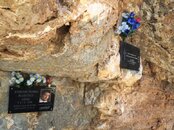There are 2 small swim through-es at Bloody Bay wall, I believe Mixing-bowl,and they refer to the short one as the swim through for chickens. I pass on doing any of them. Swim through-es are, I guess, a change of pace to make the dives more fun. I think they are an unnecessary risk, especially if they are at a deeper depth. Typically I'll follow the bubble trail, and enjoy the light. I wouldn't even think about going through the aforementioned Cozumel swim through.
I'm a bigger person, 6'4" x somewhat heavy, and don't feel like getting wedged in a death tunnel. It's always the big guy that gets stuck.
You may be thinking of the chimney and "chicken chimney" at Randy's Gazebo, Bloody Bay wall, Little Cayman. The site is named for a lovely natural stone arch at about 100 feet down the wall. The chimney is a vertical passage that leads from the hard pan at about 35' in depth, about 30' from the edge of the wall, down about 60' to a 90 degree turn and becomes a horizontal passage out to the wall itself. It is fairly narrow, and you must descend inverted (and be able to clear your sinuses inverted). It exits at about 90' depth.
That makes it about a 60' inverted vertical descent, followed by a 30' horizontal passage to the wall. It can only be done one person at a time if for no other reason than all the bubbles ascending behind each diver, and is definately not wide enough for two. It is technically a cavern, but a line is impractical - there is only one way in or out. There is dim light throughout, as in Devil's Throat - which is not completely dark at any point, although it may seem very dark. Similarly, a line at DT is impractical. All other rules of cavern diving should still apply, and I definately use a long hose to dive it (I always use one now, even in open water).
Reef Divers - a very safe dive op, brings lots of people to Randy's Gazebo, and specifically and carefully describes the chimney. They use a whiteboard, and sketch it out. They specify the tight nature of the passage and what you must be comfortable with to dive it. Perhaps 20% of guests or less choose the chimney after the briefing. I'm 6'2" 220lbs - but this thing looks narrower than it is and I would never second guess anyone who chooses to simply drop over the edge to get to the Gazebo! On the other hand, it is a fun passage, and you pop out a little hole in the wall where sometimes the reef sharks hang out - then split as a diver emerges.
Neither the chimney at the Gazebo nor Devil's Throat is a cave, IMHO. DT warrants far more caution due to the depth, the possibility of strong currents, and the darkness (although not totally dark). The Good news - DT is not filled with silt and while things can get messy with bad kicking, will not eliminate visibility. It is a sand and rock bottom, IIRC. This may be one of the reasons that accidents there have been few - nearly everyone is advised to bring a light (or has one supplied to them for the dive). This was the biggest surprise, to me, in the OP's story - that she was not advised to bring or supplied with a light.




